In Class 11 Final Exams there will be Case studies and Passage Based Questions will be asked, So practice these types of questions. Study Rate is always there to help you. Free PDF Downloads of CBSE Class 11 Chemistry Chapter 11 Case Study and Passage Based Questions with Answers were Prepared Based on the Latest Exam Pattern. Students can solve Class 11 Chemistry Case Study Questions The p-Block Elements to know their preparation level.
Join our Telegram Channel, there you will get various e-books for CBSE 2024 Boards exams for Class 9th, 10th, 11th, and 12th.
In CBSE Class 11 Chemistry Paper, There will be a few questions based on case studies and passage-based as well. In that, a paragraph will be given, and then the MCQ questions based on it will be asked.
The p-Block Elements Case Study Questions With Answers
Here, we have provided case-based/passage-based questions for Class 11 Chemistry Chapter 11 The p-Block Elements
Case Study/Passage Based Questions
Case Study 1: The heavier members of 13 and 14 groups besides the group oxidation state also show another oxidation state which is two units less than the group oxidation state. Down the group (↓), the stability of higher oxidation state decreases and that of lower oxidation state increases. This concept which is commonly called inert pair effect has been used to explain many physical and chemical properties of the element of these groups.
Heavier members of groups 13 exhibit oxidation state
(a) +3 only (b) +1 only
(c) +1 and +3 both (d) +1, +2, +3
Answer: (c) +1 and +3 both
Which among the following is the strongest oxidising agent?
(a) SiO2 (b) GeO2
(c) SnO2 (d) PbO2
Answer: (d) PbO2
Which among the following is the strongest reducing agent?
(a) GaCl (b) InCl
(c) BCl3 (d) TlCl
Answer: (c) BCl3
The strongest reductant among the following is
(a) SnCl2 (b) SnCl4
(c) PbCl2 (d) GeCl2
Answer: (d) GeCl2
Which of the following statement is wrong?
(a) Tl(III) salt undergo disproportionation.
(b) CO is used as a reducing agent.
(c) CO2 is a greenhouse gas.
(d) SiO2 is a covalent solid.
Answer: (a) Tl(III) salt undergo disproportionation.
Which of the following act as the strongest acid?
(a) Tl2O3 (b) SnO2
(c) PbO2 (d) CO2
Answer: (d) CO2
Case Study 2: Oxidation state and trends in chemical Reactivity Due to the small size of boron, the sum of its first Three ionization enthalpies is very high. This Prevents it to form +3 ions and forces it to form Only covalent compounds. But as we move from B to Al, the sum of the first three ionization Enthalpies of Al considerably decreases, and Is, therefore, able to form Al3+ ions. In fact, Aluminium is a highly electropositive metal. However, down the group, due to the poor Shielding effect of intervening d and f orbitals, The increased effective nuclear charge holds ns Electrons tightly (responsible for the inert pair Effect) and thereby, restricting their Participation in bonding. As a result of this, Only p-orbital electrons may be involved in Bonding. In fact in Ga, In, and Tl, both +1 and +3 oxidation states are observed. The relative stability of the +1 oxidation state progressively Increases for heavier elements: Al<Ga<In<Tl. In Thallium +1 oxidation state is predominant whereas the +3 oxidation state is highly Oxidising in character. The compounds in the +1 oxidation state, as expected from energy Considerations, are more ionic than those in the +3 oxidation state.
Why does boron primarily form covalent compounds rather than +3 ions?
A) Its first three ionization enthalpies are low.
B) Its first three ionization enthalpies are very high.
C) Its size is large.
D) Its oxidation state is -3.
Answer: B
Which element is mentioned as a highly electropositive metal?
A) Boron
B) Gallium
C) Aluminium
D) Thallium
Answer: C
What is the reason for the increased effective nuclear charge as we move down the group, restricting the ns electrons’ participation in bonding?
A) Strong shielding effect of intervening d and f orbitals.
B) Poor shielding effect of intervening d and f orbitals.
C) Higher atomic mass.
D) Lower atomic number.
Answer: B
In which of the following elements is the +1 oxidation state predominant?
A) Boron
B) Aluminium
C) Gallium
D) Thallium
Answer: D
How does the relative stability of the +1 oxidation state change for the elements in the given group?
A) Increases from Al to Tl.
B) Decreases from Al to Tl.
C) Remains the same from Al to Tl.
D) Increases from Tl to Al.
Answer: A
Which statement is true regarding the compounds in the +1 and +3 oxidation states?
A) Compounds in the +1 oxidation state are more covalent than those in the +3 state.
B) Compounds in the +3 oxidation state are more covalent than those in the +1 state.
C) Compounds in both oxidation states are equally covalent.
D) Compounds in the +1 oxidation state are more ionic than those in the +3 state.
Answer: D
Hope the information shed above regarding Case Study and Passage Based Questions for Class 11 Chemistry Chapter 11 The p-Block Elements with Answers Pdf free download has been useful to an extent. If you have any other queries about CBSE Class 11 Chemistry The p-Block Elements Case Study and Passage Based Questions with Answers, feel free to comment below so that we can revert back to us at the earliest possible.
By Team Study Rate




